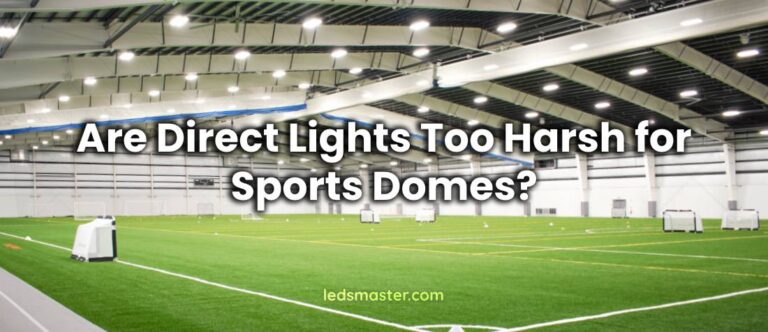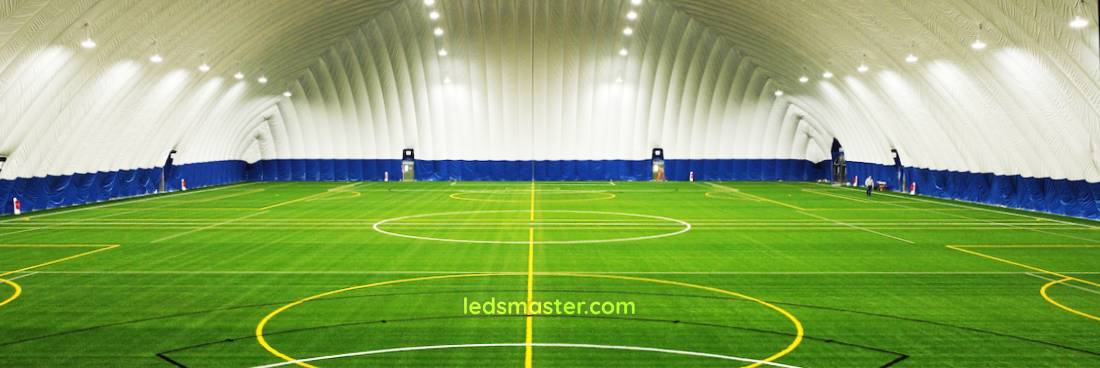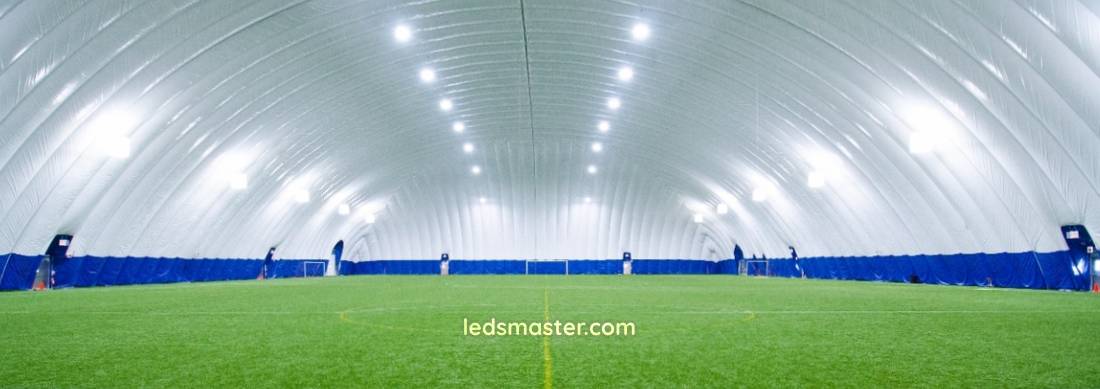
Imagine a sports dome where every game shines with perfect clarity, enhancing both player performance and spectator enjoyment. Discover how the right lighting design transforms the arena, blending technology and strategy to achieve optimal visibility and atmosphere.
Get your complimentary lighting design today
Effective lighting enhances visibility for players, spectators, and officials while also contributing to the overall atmosphere of the venue. Proper lighting design can significantly influence performance, safety, and the enjoyment of events held in the dome.
Table of Contents
ToggleHigh-Intensity Discharge (HID) lights, including metal halide and sodium vapor lamps, have been traditionally used in sports venues due to their high brightness and wide coverage. HID lighting systems provide intense illumination that can cover large areas, making them suitable for expansive sports domes. They are known for their ability to deliver powerful light, which is beneficial for visibility during both day and night events.
However, HID lights come with their own set of challenges. They generally have longer warm-up times, meaning there can be a delay before reaching full brightness. Additionally, these lights are less energy-efficient compared to newer technologies, leading to higher operational costs and more frequent maintenance requirements. Despite these limitations, HID lighting can still be effective in settings where high lumen output is necessary.

LED lighting has become a popular choice for sports domes due to its energy efficiency and superior performance. LEDs offer several advantages over traditional lighting technologies. They provide consistent, high-quality light with minimal glare and shadowing, which is crucial for ensuring clear visibility during sports events. LEDs also have a longer lifespan compared to HID lights, reducing the frequency of replacements and associated maintenance costs.
Energy efficiency is another significant benefit of LED lighting. LEDs consume considerably less power than HID lights, leading to lower electricity bills and a reduced environmental footprint. Additionally, LED systems can be equipped with advanced controls, such as dimming and color temperature adjustments, allowing for greater flexibility in managing lighting conditions based on specific needs.
Fluorescent lighting, while less common in modern sports domes, is still used in some facilities. These lights are known for their ability to deliver a broad spectrum of light and relatively even illumination. Fluorescent lights are typically more energy-efficient than traditional HID options and have a lower initial cost compared to LEDs.
However, fluorescent lighting also has its drawbacks. It can produce flickering and has a shorter lifespan compared to LEDs. Additionally, the light quality may not be as high as that provided by LED systems, which can impact visibility and performance in high-intensity sports settings. Despite these limitations, fluorescent lighting remains a viable option for some applications, particularly in smaller or budget-conscious facilities.

Achieving the appropriate lighting levels and uniformity is fundamental to effective sports dome lighting design. Different sports have specific lighting requirements based on the level of play and the nature of the activity. For example, professional sports may require higher lux levels to ensure optimal visibility and performance, while recreational or community sports might have lower requirements.
Uniformity is equally important to avoid shadows and uneven lighting, which can impact player performance and safety. Proper distribution of light across the entire field or court ensures that all areas receive adequate illumination. Achieving uniformity often involves careful planning of fixture placement and selection of lighting technology that minimizes variations in light intensity.
Managing glare and light pollution is a key aspect of sports dome lighting design. Glare can be distracting for players and spectators, affecting visibility and overall experience. Techniques to minimize glare include using well-designed fixtures with proper shielding and controlling light distribution to direct illumination where it is needed most.
Light pollution control is also important to reduce the environmental impact of the lighting system. Measures such as using fixtures with cut-off angles and shielding to prevent light spill can help minimize the effects on surrounding areas. Effective light pollution control not only enhances the quality of the lighting but also addresses community concerns related to excessive light intrusion.
The placement and mounting of lighting fixtures play a crucial role in the effectiveness of the lighting system. Fixtures should be strategically positioned to provide even coverage and avoid dark spots. For sports domes, this often involves mounting fixtures at appropriate heights and angles to achieve optimal illumination while minimizing glare.
Considerations for fixture placement include the size and shape of the dome, as well as the type of sport being played. The arrangement of fixtures should be designed to balance light distribution and ensure that all areas of the playing surface are well-lit. Additionally, mounting height and angle should be carefully selected to address specific lighting needs and achieve the desired visual quality.
Incorporating emergency lighting and backup systems into the design of a sports dome is essential for ensuring safety and compliance with regulations. Emergency lighting provides illumination in the event of a power failure, allowing for safe evacuation and continued operation during critical situations. Backup power solutions, such as generators or uninterruptible power supplies (UPS), are used to maintain lighting during outages.
Planning for emergency lighting involves identifying key areas that require backup illumination, such as exits, aisles, and critical operational zones. The integration of these systems should be carefully coordinated with the overall lighting design to ensure seamless functionality and reliability in emergencies.

The design and planning of sports dome lighting must take into account the unique structure and layout of the facility. The size, shape, and architectural features of the dome influence the lighting requirements and design approach. For example, domes with large open spaces may require more powerful lighting systems to achieve adequate coverage.
Assessing the dome’s structure also involves considering factors such as the height of the ceiling, the presence of any obstructions, and the overall layout of the playing area. Understanding these elements helps in determining the most effective lighting solutions and ensuring that the system meets the specific needs of the facility.
Selecting the appropriate lighting technology involves comparing different options based on their performance characteristics, cost, and suitability for the specific application. LED lighting is often favored for its efficiency and flexibility, but other technologies, such as HID and fluorescent lights, may still be relevant depending on the requirements and budget constraints.
When choosing lighting technology, it is important to evaluate factors such as light quality, energy consumption, and maintenance needs. Each technology has its own strengths and limitations, and the decision should be guided by the specific goals and priorities of the lighting design.
Simulation and testing are valuable tools in the lighting design process, allowing for the evaluation of different configurations and scenarios before final installation. Lighting simulation software can model the effects of various lighting layouts, helping to identify the most effective arrangement of fixtures and predict performance outcomes.
Testing is also crucial to ensure that the lighting system meets the desired specifications and performance standards. Conducting thorough tests and adjustments helps to refine the design and address any issues before the final implementation. This process ensures that the lighting system delivers optimal performance and meets the needs of the sports dome.
Routine maintenance is an integral part of managing a sports dome lighting system. Regular checks and upkeep are necessary to ensure that the lighting remains in good working condition and performs at its best. Maintenance tasks may include cleaning fixtures, inspecting wiring and connections, and replacing bulbs or components as needed.
Proactive maintenance helps to prevent potential issues and extends the lifespan of the lighting system. Developing a maintenance schedule and following best practices for upkeep can help to minimize disruptions and maintain high-quality lighting for events.
Effective energy management strategies can significantly impact the operational costs of a sports dome lighting system. Optimizing energy use involves selecting energy-efficient lighting technologies, such as LEDs, and implementing controls that adjust lighting levels based on occupancy and usage patterns.
Integration of smart controls and sensors can further enhance energy management by automating adjustments and reducing unnecessary energy consumption. These technologies contribute to lower operating costs and support sustainability goals by minimizing the environmental impact of the lighting system.
Evaluating the long-term cost and efficiency of a lighting system involves considering factors beyond the initial investment. The total cost of ownership includes ongoing expenses such as energy consumption, maintenance, and replacement of components. Choosing energy-efficient technologies and systems with lower maintenance requirements can lead to significant savings over time.
Assessing the long-term efficiency of the lighting system helps to ensure that the investment delivers value and aligns with budgetary goals. By focusing on cost-effective solutions and considering future needs, it is possible to achieve a balance between performance and financial sustainability.
For smaller sports domes, cost-effective lighting solutions are often sought. These facilities may opt for more affordable options, such as basic LED systems or traditional fluorescent lights. While the initial costs may be lower, it is important to ensure that the lighting meets the necessary performance standards for visibility and safety.
Examples of successful implementations in small-scale sports domes highlight the effectiveness of budget-friendly solutions that provide adequate illumination while remaining within financial constraints. These case studies offer valuable insights into achieving quality lighting on a smaller scale.
Large-scale sports domes typically invest in advanced lighting systems to meet the high demands of professional sports and large audiences. These installations often feature sophisticated LED technology with enhanced features such as color temperature control and advanced dimming capabilities.
Successful examples from major sports venues demonstrate the benefits of high-end lighting solutions that deliver exceptional performance and contribute to an enhanced spectator experience. The investment in advanced lighting technology supports the needs of professional events and ensures a high level of visibility and ambiance.
A comparative analysis of different lighting technologies and systems provides a comprehensive view of their relative strengths and limitations. By examining case studies and examples from various types of sports domes, it is possible to understand how different solutions perform in real-world scenarios and make informed decisions based on specific requirements and constraints.
Evaluating the effectiveness of various lighting options helps to identify the most suitable solutions for different types of sports domes, ensuring that the lighting design meets the needs of players, spectators, and facility managers.
The design of lighting systems for sports domes involves careful consideration of various factors, including lighting technology, performance requirements, and cost. By understanding the different types of lighting available and their respective benefits, it is possible to create a well-illuminated environment that enhances the overall experience. Effective lighting design balances visibility, safety, and operational efficiency, ensuring that the sports dome is equipped to support both recreational and professional events.